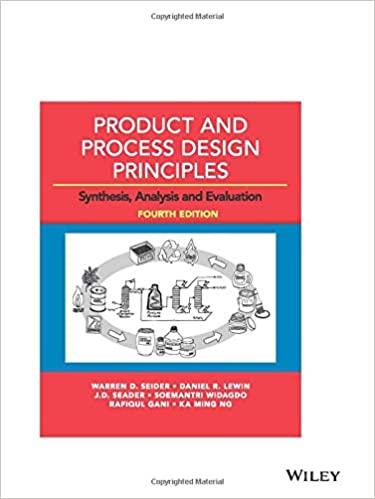Question
10. Pure Methane is heated from 303 oK to 523 oK at atmospheric pressure. Calculate the heat added per Kmol of Methane using the following
10. Pure Methane is heated from 303 oK to 523 oK at atmospheric pressure. Calculate the heat added per Kmol of Methane using the following data
| Component | a | b x 103 | c x 106 | d x 109 |
| Methane | 19.2494 | 52.1135 | 11.973 | 11.3173 |
11.Pyrites fines are roasted in a chamber plant for making Sulphuric acid. The gases leaving the roaster are at 775 oK and have molar composition SO2 7.09%, O2 10.55%, SO3 0.45 % and N2 81.91%. Calculate the heat content of 1 kmol gas mixture over 298 oK, Using the heat capacity data provided in the table:
| Component | a | b x 103 | c x 106 | d x 109 |
| SO2 | 24.7706 | 64.9481 | -44.2582 | 11.122 |
| O2 | 26.0257 | 11.7551 | -2.3426 | -0.5623 |
| SO3 | 22.0376 | 121.624 | -91.8673 | 24.3691 |
| N2 | 29.5909 | -5.141 | 13.1829 | -4.968 |
12. Check the dimensional consistency of the following empirical equation for a heat Transfer Coefficient h
h = 0.023 G0.8 k0.67 Cp0.33 D-0.2 -0.47
where h = heat Transfer Coefficient
G = mass velocity ( velocity x density )
k = Thermal conductivity
Cp = Specific Heat
D = Diameter
= Viscosity
13. The power required by an agitator in a tank is a function of the following four variables; (a) Diameter of impeller.
(b) Number of rotations of impeller per unit time.
(c) Viscosity of liquid.
(d) Density of liquid.
14. The Force F exerted on a body immersed in a flowing fluid is dependent on the relative velocity between the solid and the fluid u, the fluid density and the fluid Viscosity and length of body L.
The relationship between these variable may be written as:
F = K ua b c Ld
Where K = Dimensionless Constant.
From the above relationship prove that F = K L2 u2 ( NRe)-c
15 a.Enlist the relationship between the Concentration and Conversion for Constant density Batch reactor as well as varying density Batch reactor.
b. At 500 oK the rate of a bimolecular reaction is ten times the rate at 400 oK. Find the activation energy of this reaction:
a. From Arrhenius law.
b. From collision theory.
c. How much does a reaction rate with an activation energy 15000 cal/mole vary when the temperature is increased from 300 oK to 310 oK and from 300 oK to 400 oK.
d. Calculate the activation energy and Frequency factor from the following data. Also predict the Order of the reaction.
K Sec-143 x 10-5717 x 10-5
T oK 313 333
e. Explain Molecularity and Order of Reaction .Also find the unit of Rate constant k for Second Order Reaction.
f. Describe about the different types of intermediates in non-elementary reactions. g. Explain with Suitable examples the Single and Multiple Reactions as well as Elementary and Non Elementary Reactions?
16. a.Liquid A decomposes by first order kinetics and in a batch reactor, 40 % of A is converted in a 8 minute run. How much longer it would take for 95% Conversion?
b.A 20 minute experiment run shows that 85 % of liquid reactant is converted to product by a order rate. What would be the amount converted in 40 minute run?
17 a.For the reaction of type 2A P , Find the A(Fractional change in Volume) if 40 % inert present at the start.
b. For the reaction of type A 2P , Find the A(Fractional change in Volume) if 20 % inert present at the start.
18 a. Liquid A decomposes by first order kinetics and in a batch reactor, 50 % of A is converted in a 6 minute run. How much longer it would take for 75% Conversion?
b. Liquid A decomposes by first order kinetics and in a batch reactor, 40 % of A is converted in a 8 minute run. How much longer it would take for 95% Conversion?
Step by Step Solution
There are 3 Steps involved in it
Step: 1

Get Instant Access to Expert-Tailored Solutions
See step-by-step solutions with expert insights and AI powered tools for academic success
Step: 2

Step: 3

Ace Your Homework with AI
Get the answers you need in no time with our AI-driven, step-by-step assistance
Get Started


